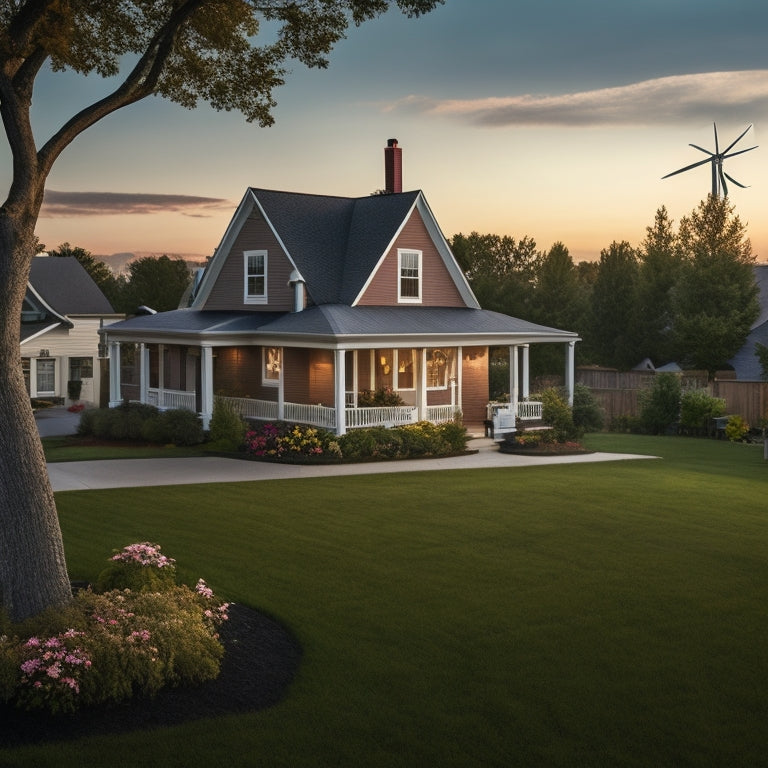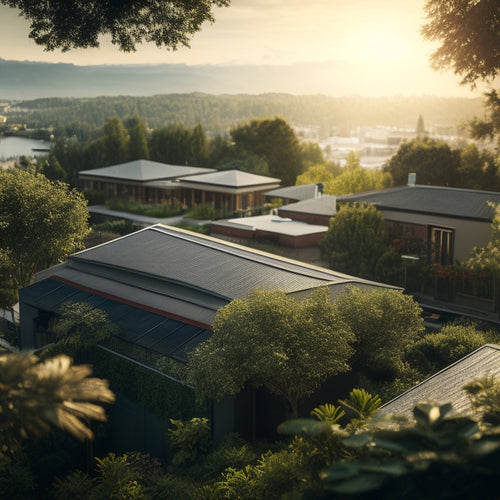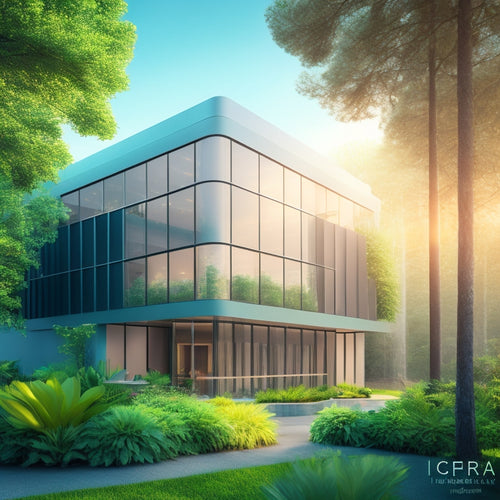
Why Residential Wind Turbines Face Zoning Hurdles
Share
You face a complex web of zoning laws, local ordinances, and regulatory obstacles when attempting to install a residential wind turbine. Zoning laws often restrict turbine size, location, and type, while local ordinances may prohibit installation or impose impractical requirements. Height and setback requirements can complicate turbine placement, and noise, aesthetic, and environmental concerns can lead to community opposition. You'll need to maneuver through permits, approval processes, and neighborhood notification, as well as potential Homeowners Association restrictions. To overcome these zoning obstacles, you must carefully consider each factor and understand the complexities of local regulations, which will require a detailed understanding of the rules and requirements that govern your project.
Key Takeaways
- Zoning laws and local ordinances often restrict size, location, and type of residential wind turbines, hindering installation.
- Excessive setback distances from property lines can complicate turbine placement and reduce energy output.
- Height and setback requirements, such as maximum heights of 30-80 feet, can affect project feasibility and expenses.
- Community concerns about noise, aesthetics, and environmental impacts can lead to opposition and zoning hurdles.
- Non-compliance with local zoning laws, building codes, and environmental regulations can result in project cancellation or legal issues.
Zoning Laws and Local Ordinances
Zoning laws and local ordinances often stand as significant barriers to the installation of residential wind turbines. You may encounter zoning challenges that restrict the size, location, and type of wind turbine you can install on your property.
Residential regulations can be overly restrictive, prohibiting the installation of turbines altogether or imposing impractical requirements. For instance, some ordinances may require turbines to be set back an excessive distance from property lines or roads, making it difficult to find a suitable location.
In addition, the integration of renewable energy sources and energy storage systems can also be impacted by these regulations. Furthermore, fast charging infrastructure and urban charging hubs, as seen in commercial EV charging stations, can serve as a model for overcoming these obstacles.
You must maneuver through these regulations carefully to guarantee your turbine complies with local laws. Understanding the specific zoning laws and ordinances in your area is vital to overcoming these obstacles and successfully installing a residential wind turbine.
Height and Setback Requirements
How high can your residential wind turbine stand, and how far back from property lines must it be set? These are vital questions when it comes to turbine efficiency and installation costs.
Typically, zoning laws dictate a maximum height for residential wind turbines, ranging from 30 to 80 feet, depending on the jurisdiction. Setback requirements also vary, with some areas requiring a minimum distance of 1.5 to 2 times the turbine's height from property lines.
Similar to commercial EV charging stations, installation costs can range considerably, from $500 to $50,000+, depending on complexity, accessibility, and permits. These restrictions can greatly impact your turbine's energy output and installation expenses.
Noise and Aesthetic Concerns
As you maneuver through the complexities of installing a residential wind turbine, you'll encounter another set of obstacles: noise and aesthetic concerns. These concerns can be a major hurdle in getting your project approved, as they often spark debate among community members.
Some common concerns regarding noise and aesthetics include:
-
Noise levels: turbines can generate sound levels ranging from 35-60 decibels, which can be disturbing to nearby residents, similar to the importance of regular maintenance and inspections in preventing downtime and contributing to sustainable fleet operations.
-
Turbines can also impact energy consumption patterns, which can be identified and optimized through daily monitoring of energy output and analysis.
-
Turbine aesthetics: the visual impact of turbines can be a sensitive topic, with some finding them unsightly or obtrusive.
-
Community perceptions: negative perceptions of wind turbines can be fueled by misconceptions or lack of education on the technology.
-
Shadow flicker: the rotating blades can create a flickering effect on nearby surfaces, which can be annoying to some.
-
Visual impact on natural settings: turbines can alter the natural scenery, affecting the area's character and charm.
Property Value and NIMBYism
By the time you've maneuvered the complexities of noise and aesthetic concerns, you'll face another significant challenge: property value and NIMBYism (Not In My Backyard) opposition.
This hurdle stems from concerns that residential wind turbines will negatively impact property aesthetics, leading to decreased property values. Additionally, the increased adoption of electric vehicles and solar EV charging stations Environmental Benefits may further exacerbate concerns about property values.
Community attitudes play a significant role, as nearby residents may view turbines as unsightly or obtrusive, affecting their quality of life.
You'll need to address these concerns by providing data on the turbines' visual impact and any potential effects on property values. Additionally, engaging with local communities to educate them on the benefits of residential wind turbines can help shift attitudes and build support for your project.
Environmental Impact Assessments
You'll need to contemplate the potential environmental implications of residential wind turbines, particularly regarding noise pollution effects and wildlife habitat disruption.
As you assess the environmental impact of these turbines, you'll want to quantify the noise levels generated and evaluate their potential disturbance to local wildlife populations.
Renewable energy systems, such as solar panels fuel cost reductions, can offer a more environmentally friendly alternative.
This analysis will help you identify potential mitigation strategies to minimize the turbines' ecological footprint.
Noise Pollution Effects
Several studies have consistently shown that wind turbines can generate significant noise levels, particularly in the low-frequency range, which can have adverse effects on nearby residents.
As you consider installing a residential wind turbine, it's crucial to understand the potential noise pollution effects.
-
Noise levels can exceed 40 decibels, equivalent to a refrigerator humming in the background
-
Low-frequency noise can cause sleep disturbance, anxiety, and other health issues
-
Proper sound mitigation measures, such as turbine placement and soundproofing, can reduce noise impact
-
Community education and awareness about noise pollution effects can lead to more informed decision-making
-
Regular noise monitoring and assessment can help identify and address potential issues
Wildlife Habitat Disruption
One of the most critical environmental impact assessments to evaluate when installing a residential wind turbine is its potential disruption to local wildlife habitats. As you consider installing a wind turbine, you'll need to assess how it may affect the natural habitats of local species. Habitat fragmentation, where natural habitats are broken up by human-made structures, can have devastating effects on local ecosystems. Additionally, wind turbines can disrupt bird migration patterns, leading to collisions and fatalities.
| Impact | Effect on Wildlife |
|---|---|
| Habitat Fragmentation | Disrupts natural habitats, leading to population decline |
| Bird Migration Disruption | Causes bird collisions and fatalities |
| Noise Pollution | Disrupts communication and behavior patterns |
| Visual Impact | Alters natural scenery, affecting species behavior |
| Electromagnetic Interference | Disrupts migratory patterns and guidance systems |
Federal and State Incentives
Since the early 2000s, federal and state governments have been actively promoting the adoption of residential wind turbines by offering various incentives to homeowners.
You can benefit from these programs, which aim to reduce the cost of installing a wind turbine and increase your energy independence.
Some of the incentives you can take advantage of include:
- Federal incentives: 30% tax credit for wind turbine installation costs
- State programs: rebates, grants, and property tax exemptions
- Net metering laws: allowing you to sell excess energy back to the grid
- Renewable energy certificates (RECs): providing additional revenue streams
- Streamlined permitting processes: reducing bureaucratic obstacles
Permits and Approval Processes
You'll need to maneuver a series of permits and approval processes before installing a residential wind turbine.
This involves complying with local ordinances, which often require you to notify neighboring properties of your installation plans and obtain their consent.
You must also guarantee your turbine meets specific noise, height, and setback requirements outlined in local zoning laws.
Neighborhood Notification Rules
As you maneuver through the process of installing a residential wind turbine, neighborhood notification rules emerge as an essential aspect of permits and approval processes.
These rules guarantee that nearby residents are informed about the proposed installation, nurturing community engagement and public awareness.
Some key requirements to keep in mind include:
- Posting clear notices in local newspapers or online platforms
- Distributing flyers or door-to-door notifications to adjacent properties
- Holding public meetings or open houses to address concerns
- Providing written notice to nearby property owners and local authorities
- Allowing a specified timeframe for comments and feedback before approval
Local Ordinance Compliance
Steering through the complexities of local ordinances is an essential step in securing the necessary permits and approvals for your residential wind turbine installation.
You'll need to guarantee compliance with zoning laws, building codes, and environmental regulations. Failure to comply can result in costly delays, fines, or even project cancellation.
It's vital to engage with your community and involve local authorities early on to avoid potential legal implications. This includes submitting detailed plans, attending public hearings, and addressing concerns from neighbors and local officials.
Homeowners Association Restrictions
Some homeowners may face restrictions from their homeowners association (HOA) when attempting to install a residential wind turbine.
Before installing a turbine, you should review your HOA's covenants, conditions, and restrictions (CC&Rs) to guarantee compliance.
You may encounter restrictions related to:
- Turbine design, including size, color, and material
- Installation location, such as setbacks from property lines or neighboring homes
- Noise levels, as some HOAs may have quiet hours or noise ordinances
- Aesthetic concerns, including visual impact on the community
- Community engagement, as some HOAs may require approval from the board or neighbors
Safety and Liability Issues
Get ready to steer through the complex web of safety and liability concerns that come with installing a residential wind turbine.
You'll need to guarantee turbine safety by adhering to strict installation and maintenance guidelines. Failure to do so can lead to catastrophic consequences, including property damage and personal injury.
To mitigate these risks, you'll need liability insurance to protect yourself and others from potential harm. This insurance will cover damages and injuries resulting from turbine malfunctions or accidents.
Be prepared to provide proof of insurance and compliance with safety standards to local authorities before they grant you permission to install your turbine.
Alternative Energy Options
Your alternatives to residential wind turbines include solar panels, geothermal systems, and biomass generators, each offering unique advantages and drawbacks. If you're looking for energy independence and a reduced carbon footprint, these options may be worth exploring.
-
Solar panels provide clean technology and energy efficiency, but may require significant upfront investment and battery storage.
-
Geothermal energy utilizes renewable resources, but is often limited by location and infrastructure requirements.
-
Biomass generators offer a sustainable alternative, but can be noisy and produce air pollutants.
- Solar panels can be paired with wind energy to provide a hybrid system, increasing energy output and reducing reliance on traditional power sources.
Frequently Asked Questions
Can I Install a Wind Turbine on a Rented Property?
You'll likely need to review your rental agreements and obtain explicit property owner permissions before installing a wind turbine on a rented property, ensuring you're not violating any terms or infringing on the owner's rights.
Are Wind Turbines Compatible With Solar Panel Systems?
As you utilize the power of renewable energy, you'll find wind turbines and solar panels can harmoniously coexist, like two wings of a sustainable eagle, with compatible systems integrating wind turbine power with solar energy, maximizing your freedom from fossil fuels.
Do Wind Turbines Attract Lightning Strikes?
You wonder if wind turbines attract lightning strikes; the answer is yes, but modern turbine designs incorporate advanced lightning protection systems, minimizing risks, and ensuring safe, efficient energy generation for your freedom-seeking pursuits.
Can Wind Turbines Be Used for Irrigation Pumping?
You can utilize wind energy to power irrigation systems, increasing irrigation efficiency while reducing your reliance on fossil fuels. By installing a wind turbine, you'll be able to pump water more sustainably, conserving resources and enjoying greater energy independence.
Are There Financing Options for Residential Wind Turbines?
As you chase the dream of energy independence, you'll find financing options for residential wind turbines, like government incentives and rebates, which can help offset installation costs, making your sustainable vision more attainable.
Related Posts
-

Why Choose Cool Roofs in Scorching Climates?
You opt for cool roofs in scorching climates because they enable you to reclaim control over your energy consumption ...
-

Gamify Your Home's Energy Generation and Savings
You're taking the next step in optimizing your home's energy generation and savings by utilizing the power of gamific...
-

7 Top HEPA Filters for Green Building Projects
You need a reliable HEPA filter for your green building project that aligns with your sustainable goals and guarantee...


